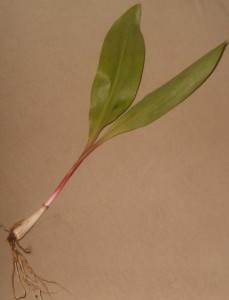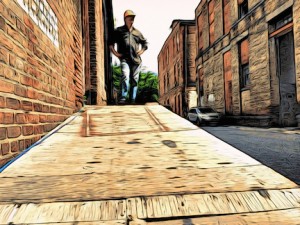If you’ve ever taken I-70 through the Rockies, you’ve probably seen those steep gravel turnoffs leading up from the road, then abruptly dead-ending, as well as all the signs advertising them.
 Those are runaway truck ramps, and they’re for semis whose brakes have blown.
Those are runaway truck ramps, and they’re for semis whose brakes have blown.
The idea is pretty simple: an out-of-control truck can’t stop, so the driver keeps his foot off the gas, waits for a truck ramp, then expends all the truck’s momentum going up it.
In practice, though, these ramps are pretty complicated.
First off, you’ve got to make sure the truck won’t roll back down. One way to do that is to have a long flat stretch after an initial rise (though this obviously doesn’t work in the Rockies).
 Another version uses sand to absorb all the momentum: semi tires are big, but not big enough to take a semi through sand. The problem with sand ramps is that the semis have a tendency to flip on them.
Another version uses sand to absorb all the momentum: semi tires are big, but not big enough to take a semi through sand. The problem with sand ramps is that the semis have a tendency to flip on them.
Finally, there are the ones made of loose, ungraded gravel. They work great but rip up tires and undercarriages.
Steep gravel ramps—like the ones on I-70 are the most common. Moderate damage is better than overturning or rolling back onto the road. It’s not an overly complicated issue, but the sheer force of a fast-moving semi complicates the solution, especially since they’re nowhere near as durable as they are in movies.
All of that said: never, ever drive a non-semi vehicle up there. It will not survive.
 the TV. I can’t say as I’m a huge fan now, but I can definitely see the appeal. (Except for robots. We’ve already lost enough jobs to them; manufacturing lines hardly even need people anymore.)
the TV. I can’t say as I’m a huge fan now, but I can definitely see the appeal. (Except for robots. We’ve already lost enough jobs to them; manufacturing lines hardly even need people anymore.) I don’t know how much power teleporters use, but I feel like it can’t be cheap to run one. Plus, the teleporters come out in those nice, carpeted rooms. They can’t possibly load all their stuff from there. There’d be marks all over the carpet.
I don’t know how much power teleporters use, but I feel like it can’t be cheap to run one. Plus, the teleporters come out in those nice, carpeted rooms. They can’t possibly load all their stuff from there. There’d be marks all over the carpet.

 The Aztecs were real tricky to find stuff on. Almost every supposed “source” detailing its construction techniques immediately starts going on about how they sacrificed people during construction, then doesn’t bother to actually discuss the techniques they used. I’m no trained historian, but that seems like sensationalism to me, and it sure doesn’t answer my questions.
The Aztecs were real tricky to find stuff on. Almost every supposed “source” detailing its construction techniques immediately starts going on about how they sacrificed people during construction, then doesn’t bother to actually discuss the techniques they used. I’m no trained historian, but that seems like sensationalism to me, and it sure doesn’t answer my questions. The Incans were the easiest to find information on, since most of the stuff on the Internet is about their construction techniques anyhow. Their buildings were famed for being constructed of huge stone blocks in irregular patterns that for together perfectly, without gaps. You can’t even stick a knife between the stones.
The Incans were the easiest to find information on, since most of the stuff on the Internet is about their construction techniques anyhow. Their buildings were famed for being constructed of huge stone blocks in irregular patterns that for together perfectly, without gaps. You can’t even stick a knife between the stones. I had a brand new Schwinn, and he had one of those heavy black Raleigh bikes from England. The boards were resting on the cinder block at about a 45-degree angle. I went first, on account of John being quite a bit smarter than me. I moved right up against his house to get the fastest start I could. I came at the ramp straight on and made it onto the board I was aiming at, which then promptly broke in half, and I crashed full speed into the cinder blocks.
I had a brand new Schwinn, and he had one of those heavy black Raleigh bikes from England. The boards were resting on the cinder block at about a 45-degree angle. I went first, on account of John being quite a bit smarter than me. I moved right up against his house to get the fastest start I could. I came at the ramp straight on and made it onto the board I was aiming at, which then promptly broke in half, and I crashed full speed into the cinder blocks. John, meanwhile, hadn’t bothered to watch me go down. When he saw me ramp, he just had to go himself. He used a different, longer board than I did. As soon as his back wheel hit the end of the board, it flipped up into the air like it were part of a catapult, flew through the air, and somehow managed to land on one end on my injured arm between the wrist and elbow, breaking it a second time before bouncing farther down the hill.
John, meanwhile, hadn’t bothered to watch me go down. When he saw me ramp, he just had to go himself. He used a different, longer board than I did. As soon as his back wheel hit the end of the board, it flipped up into the air like it were part of a catapult, flew through the air, and somehow managed to land on one end on my injured arm between the wrist and elbow, breaking it a second time before bouncing farther down the hill.